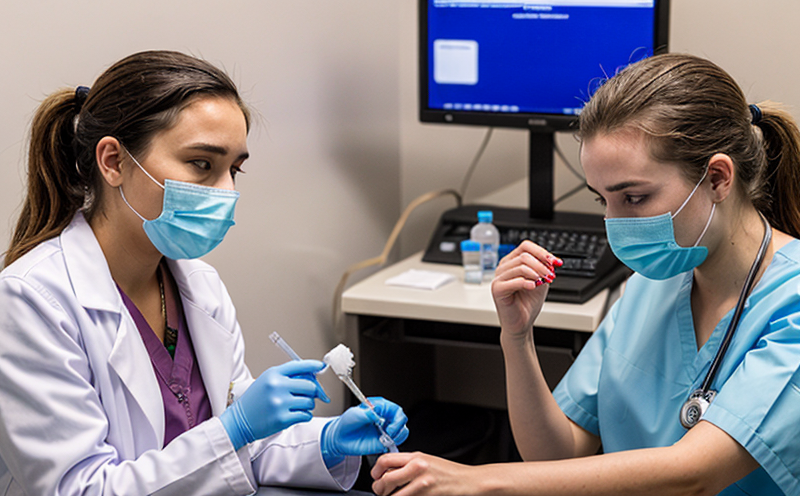ISO 20776 Antimicrobial Susceptibility Testing in Clinical Labs
The ISO 20776 standard is a cornerstone in the field of clinical microbiology, specifically designed to ensure accurate and reliable antimicrobial susceptibility testing (AST) for pathogens that infect humans. This standard provides detailed methodologies for performing AST using broth microdilution, disk diffusion, and Etest methods. The importance of this service cannot be overstated as it directly impacts patient outcomes by guiding the appropriate selection of antibiotics.
The process begins with careful preparation of specimens from patients suspected of having an infection. These samples are then inoculated into media that supports the growth of the targeted pathogen. Once colonies have formed, they are transferred to test tubes containing various concentrations of antimicrobial agents. The standard specifies strict guidelines for incubation conditions and reading criteria to ensure consistency across laboratories.
Understanding the nuances of this process is critical for quality managers and compliance officers who oversee clinical microbiology departments. For R&D engineers involved in developing new drugs, proficiency with these tests allows them to better understand how their products interact with different pathogens. Meanwhile, procurement teams benefit from knowing that adherence to such standards ensures they are purchasing validated reagents and equipment.
The standard also emphasizes the importance of quality assurance measures within laboratories. Regular calibration of instruments used in AST is paramount to maintaining accuracy. Additionally, personnel must undergo training specific to performing these tests according to ISO 20776 guidelines. Compliance officers play a crucial role here by ensuring that all staff members are up-to-date on best practices.
One key aspect often overlooked but critical for success is the interpretation of results. Misinterpretation can lead to incorrect treatment decisions, which could exacerbate resistance issues. Therefore, laboratories must have robust protocols in place for reviewing and validating interpretations before reporting them to clinicians.
In summary, ISO 20776 provides a structured approach that enhances reliability and consistency when conducting ASTs. By following these stringent procedures, clinical microbiology labs can contribute significantly towards improving patient care while also supporting broader public health goals.
Why It Matters
The significance of accurate antimicrobial susceptibility testing (AST) cannot be overstated given the increasing threat posed by antibiotic-resistant bacteria. Inappropriate use or misuse of antibiotics can lead to ineffective treatments, prolonged illness, and even death. Therefore, ensuring that ASTs are performed correctly is essential not only for individual patients but also for public health.
ISO 20776 plays a vital role in promoting high-quality AST practices by providing clear instructions on how to perform these tests consistently across different laboratories worldwide. This consistency ensures that healthcare providers can trust the results they receive, leading to more effective treatment strategies and better patient outcomes.
- Improved Patient Care: Accurate ASTs help clinicians choose the most appropriate antibiotics for each patient's infection, thereby improving therapeutic efficacy.
- Reduced Resistance: By using correct AST methods, healthcare providers can minimize unnecessary use of broad-spectrum antibiotics, which helps prevent the development and spread of resistant strains.
- Better Resource Utilization: Properly conducted ASTs allow for targeted therapy, reducing the need for extensive empirical treatments that may not be effective against certain pathogens.
- Enhanced Laboratory Reputation: Adherence to international standards like ISO 20776 enhances a laboratory's credibility and reputation among healthcare providers and regulatory bodies alike.
The stakes are high when dealing with infectious diseases. Any deviation from best practices could lead to severe consequences for both patients and society at large. That is why laboratories must invest in proper training, equipment calibration, and continuous quality assurance processes to ensure compliance with ISO 20776 standards.
Industry Applications
- Hospitals: Hospitals frequently rely on ASTs to determine the best course of treatment for patients with infections. By adhering to ISO 20776, hospitals can provide more precise and effective care.
- Nursing Homes: Nursing homes often face challenges related to elderly residents who are particularly susceptible to infections. Performing ASTs according to this standard helps ensure that these facilities have the tools necessary to combat such issues effectively.
- Dental Clinics: Dental clinics may occasionally encounter cases where bacteria resistant to common antibiotics pose a risk. Implementing AST protocols based on ISO 20776 ensures that dentists can manage these situations appropriately.
- Research Institutions: Research institutions involved in studying infectious diseases benefit greatly from consistent AST methodologies provided by ISO 20776, allowing for more reliable data collection and analysis.
In addition to these primary applications, ISO 20776 also supports secondary markets such as pharmaceutical companies developing new antibiotics. These entities can use the standardized procedures outlined in this document to evaluate their products' efficacy against various pathogens effectively.
Environmental and Sustainability Contributions
The adoption of ISO 20776 not only benefits human health but also contributes positively to environmental sustainability efforts. Here are some ways:
- Reduced Antibiotic Waste: By ensuring that antibiotics are used appropriately through accurate ASTs, there is less likelihood of residual drugs ending up in wastewater systems.
- Lower Carbon Footprint: Standardized procedures reduce the need for extensive retesting due to improper initial testing, thus minimizing resource consumption and associated emissions.
- Promotion of Green Chemistry: The emphasis on accurate ASTs encourages the development of greener alternatives in antimicrobial therapy research.
These contributions align with broader sustainability goals aimed at reducing environmental impact while enhancing healthcare quality. As more laboratories adopt these practices, we see a positive ripple effect across multiple sectors contributing to overall improvement.





